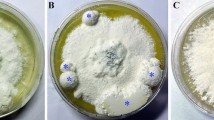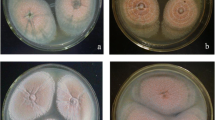Abstract
Morels are some of the most highly prized edible and medicinal mushrooms, and the outdoor cultivation has been achieved in China in recent years. Sclerotial formation is one of the most important phases during the morel life cycle, and the number of sclerotia indicates the spawn quality during cultivation. However, the sclerotial formation and differentiation mechanisms are poorly understood. In this study, the sclerotial formation process of Morchella importuna and the effects of reactive oxygen species on scerotial formation were studied. Scerotial formation was defined as five distinctive phases, hypha early, hyphal growth, sclerotial initiation, development, and maturation. The mycelia in the sclerotium-forming area were swollen, darkened, and dense with sclerotial formation, but hydrogen peroxide accumulated in the region lacking sclerotial formation. The expression of all six genes for superoxide dismutases tested increased with sclerotial maturation. A difference in hydrogen peroxide concentration of 20 mM could promote the sclerotial initiation and induce expression of sod genes. The MAPK signaling pathway was activated, and they passed the signal from an area of high oxidative stress to a low area to initiate sclerotial formation. An understanding of the sclerotial formation mechanisms in M. importuna may help to understand the life cycle and facilitate the fruiting body cultivation.








Similar content being viewed by others
References
Allen RG (1991) Oxygen-reactive species and antioxidant responses during development: the metabolic paradox of cellular differentiation. Proc Soc Exp Biol Med 196(2):117–129. https://doi.org/10.3181/00379727-196-43171A
Aguirre J, Ríos-Momberg M, Hewitt D, Hansberg W (2005) Reactive oxygen species and development in microbial eukaryotes. Trends Microbiol 13(3):111–118. https://doi.org/10.1016/j.tim.2005.01.007
Cargnello M, Roux PP (2011) Activation and function of the MAPKs and their substrates, the MAPK-activated protein kinases. Microbiol Mol Biol Rev 75(1):50–83. https://doi.org/10.1128/MMBR.00031-10
Fang GC, Hanau RM, Vaillancourt LJ (2002) The sod2 gene, encoding a manganese-type superoxide dismutase, is up-regulated during conidiogenesis in the plant-pathogenic fungus Colletotrichum graminicola. Fungal Genet Biol 36(2):155–165. https://doi.org/10.1016/S1087-1845(02)00008-7
He PX, Liu W, Cai YL, Ma BJ, Chen LT, Wu XR (2014) Effects of oxidative stress on mycelial growth and sclerotial metamorphosis of Morchella crassipes. Hubei Agric Sci 53(13):3085–3089. https://doi.org/10.14088/j.cnki.issn0439-8114.2014.13.091
Liu XR, Chen FC, Tan FH, Lin Q (2004) A study of the sclerotium producing conditions of Morchella sp. J Sichuan For Sci Technol 25(3):44–47. https://doi.org/10.16779/j.cnki.1003-5508.2004.03.010
Liu QZ, Ma HS, Zhang Y, Dong CH (2017) Artificial cultivation of true morels: current state, issues and perspectives. Crit Rev Biotechnol 38(2):259–271. https://doi.org/10.1080/07388551.2017.1333082
Georgiou CD (1997) Lipid peroxidation in Sclerotium rolfsii: a new look into the mechanism of sclerotial biogenesis in fungi. Mycol Res 101:460–464. https://doi.org/10.1017/S0953756296002882
Georgiou CD, Sideri M (2000) Colorimetric method for determining hydrogen peroxide production in liquid media by filamentous fungi. Mycologia 92(5):835–840. https://doi.org/10.2307/3761578
Georgiou CD, Patsoukis N, Papapostolou L, Zervoudakis G (2006) Sclerotial metamorphosis in filamentous fungi is induced by oxidative stress. Integr Comp Biol 46(6):691–712. https://doi.org/10.1093/icb/icj034
Király I, Czövek P (2007) Oxidative burst induced pseudosclerotium formation of Morchella steppicola Zerova on different malt agar media. Can J Microbiol 53(8):975–982. https://doi.org/10.1139/W07-055
Papapostolou I, Georgiou CD (2010a) Hydrogen peroxide is involved in the sclerotial differentiation of filamentous phytopathogenic fungi. J Appl Microbiol 109(6):1929–1936. https://doi.org/10.1111/j.1365-2672.2010.04822.x
Papapostolou I, Georgiou CD (2010b) Superoxide radical is involved in the sclerotial differentiation of filamentous phytopathogenic fungi: identification of a fungal xanthine oxidase. Fungal Biol 114(5–6):387–395. https://doi.org/10.1016/j.funbio.2010.01.010
Papapostolou I, Georgiou CD (2010c) Superoxide radical induces sclerotial differentiation in filamentous phytopathogenic fungi: a superoxide dismutase mimetics study. Microbiology 156(Pt 3):960–966. https://doi.org/10.1099/mic.0.034579-0
Sudbery PE (2011) Growth of Candida albicans hyphae. Nat Rev Microbiol 9(10):737–748. https://doi.org/10.1038/nrmicro2636
Segmüller N, Ellendorf U, Tudzynski B, Tudzynski P (2007) Bcsak1, a stress-activated mitogen-activated protein kinase, is involved in vegetative differentiation and pathogenicity in Botrytis cinerea. Eukaryot Cell 6(2):211–221. https://doi.org/10.1128/EC.00153-06
Sheng Y, Abreu IA, Cabelli DE, Maroney MJ, Miller AF, Teixeira M, Valentine JS (2014) Superoxide dismutases and superoxide reductases. Chem Rev 114(7):3854–3918. https://doi.org/10.1021/cr4005296
Smith ME, Henkel TW, Rollins JA (2015) How many fungi make sclerotia? Fungal Ecol 13:211–220. https://doi.org/10.1016/j.funeco.2014.08.010
Tomoyuki O, Pyoyun P, Kenichi I (2017) Cytological analysis of the effect of reactive oxygen species on sclerotia formation in Sclerotinia minor. Fungal Biol 121(2):127–136. https://doi.org/10.1016/j.funbio.2016.11.002
Volk TJ, Leonard TJ (1989) Experimental studies on the morel. I. Heterokaryon formation between monoascosporous strains of Morchella. Mycologia 81(4):523–531. https://doi.org/10.2307/3760127
Volk TJ, Leonard TJ (1990) Cytology of the life-cycle of Morchella. Mycol Res 94(3):399–406. https://doi.org/10.1016/S0953-7562(09)80365-1
Xu JR (2000) Map kinases in fungal pathogens. Fungal Genet Biol 31(3):137–152. https://doi.org/10.1006/fgbi.2000.1237
Funding
This study was funded by the Coal-based Key Scientific and Technological Project from Shanxi Province (FT2014-03-01) and Key Research and Development Program from Guangxi Province (2016AB05317).
Author information
Authors and Affiliations
Corresponding author
Ethics declarations
Conflict of interest
The authors declare that they have no conflict of interest.
Ethical approval
This article does not contain any studies with human participants or animals performed by any of the authors.
Electronic supplementary material
ESM 1
(PDF 490 kb)
Rights and permissions
About this article
Cite this article
Liu, Q., Zhao, Z., Dong, H. et al. Reactive oxygen species induce sclerotial formation in Morchella importuna. Appl Microbiol Biotechnol 102, 7997–8009 (2018). https://doi.org/10.1007/s00253-018-9104-4
Received:
Revised:
Accepted:
Published:
Issue Date:
DOI: https://doi.org/10.1007/s00253-018-9104-4




